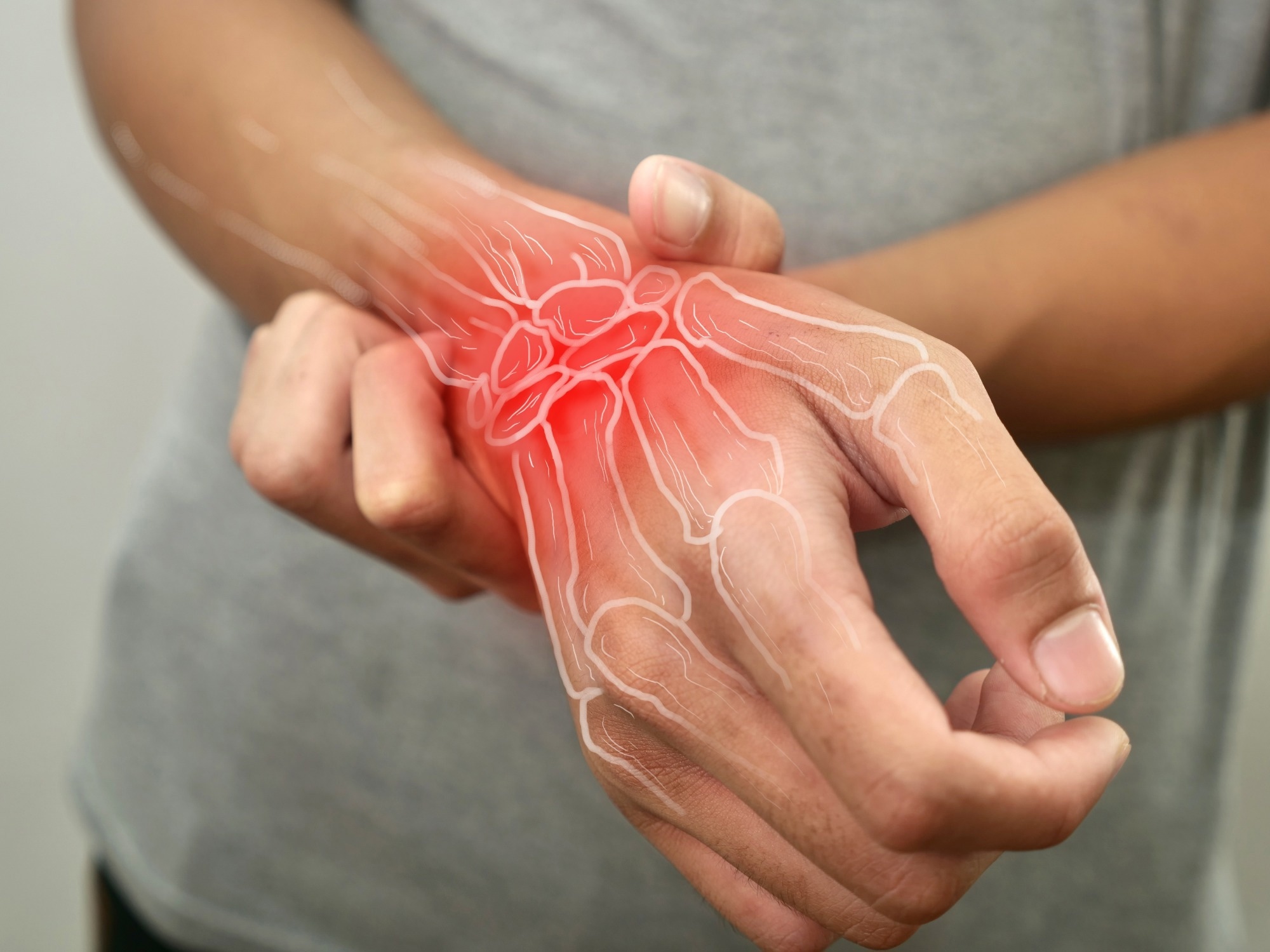In a recent study published in Scientific Reports, researchers determined the relationship between serological testosterone levels and arthritis among United States (US) adults.
 Study: Lower serum testosterone is associated with increased likelihood of arthritis. Image Credit: airdone/Shutterstock.com
Study: Lower serum testosterone is associated with increased likelihood of arthritis. Image Credit: airdone/Shutterstock.com
Background
Arthritis is a joint disease that affects the hyaline articular cartilage, surrounding tissues, and subchondral bone. Hormonal variables, such as testosterone, have been linked to the growth and development of knee osteoarthritis (KOA).
Androgens have been proven in studies to activate non-genetic and non-genetic mechanisms, with the fastest evidence being a rapid rise in the intercellular concentration of calcium.
Physiological testosterone dosages have been demonstrated to improve cartilage production among males with advanced-stage osteoarthritis, and testosterone replacement treatment enhances articular cartilage regeneration in affected individuals.
Androgens are also implicated in osteoblast formation and development, according to research. However, there is minimal evidence of sex-specific relationships between serological testosterone expression and osteoarthritis, and the link between plasma testosterone among arthritic individuals and disease progression is not clear.
About the study
In the present study, researchers investigated the influence of serological testosterone levels on arthritis pathophysiology.
Data from 10,439 adults who participated in the 2013–2016 National Health and Nutrition Examination Survey (NHANES) were analyzed by multivariable logistic regression modeling performed to determine the odds ratios (ORs).
The model estimations were adjusted for covariates such as age, gender, race, educational attainment, marital status, income, alcohol intake, smoking status, test reports, laboratory findings, survey responses, and comorbidities (such as diabetes, cardiovascular diseases, and hypertension).
In addition, generalized additivity modeling and smoothed curve fitting were performed. The database samples were selected by stratified multiple-stage sampling.
Data collection methods included at-home interviews to collect demographic, dietary, and health-associated data and medical examinations to collect data from laboratory investigations [including sex hormone binding globulin (SHBG) and estradiol] and physical assessment records [including body mass index (BMI) and waistline].
Individuals were queried if they had received an arthritis diagnosis by physicians or other medical professionals, and if yes, were requested to state their condition type as rheumatoid arthritis, osteoarthritis, or other.
The Centers for Disease Control and Prevention (CDC)-designed isotope dilution-liquid chromatography-tandem mass spectrometry (ID-LC-MS) technique was used to ascertain TT concentrations.
Results
Initially, 20,146 individuals were identified, of whom 5,380 and 4,327 were excluded due to missing data on serological testosterone levels and arthritis development, respectively. Among the 10,439 study participants, 48% were male, with a mean age of 47 years and a mean serum testosterone level of 215. Among the participants, 27% developed arthritis.
Arthritic individuals showed lower serum testosterone than their non-arthritic counterparts, in line with previous studies. Linear regression analysis findings showed a statistically significant negative link between serological testosterone levels and arthritis.
Likewise, the univariable multivariable analyses of Q4, using Q1 for reference, showed a significantly lower risk of arthritis development.
In particular, sensitivity analyses using quartiles of serum testosterone resulted in odds ratios of 1.0, 0.9, 0.5, and 0.5 for the first quartile, second quartile, third quartile, and fourth quartile in the fully adjusted model, respectively.
Individuals in the uppermost quartile of serum testosterone levels showed a 51% lower risk of arthritis development compared to individuals belonging to the lowermost quartile.
Smoothed curve fitting showed a non-linear association between arthritis development and serological testosterone levels. The subgroup analyses showed that the negative link between serological testosterone and developing arthritis was more statistically significant among older female smokers with comorbidities and body mass index (BMI) values of 30 kg per m2 and higher.
Testosterone and estradiol are natural immunosuppressants that suppress antibody- and cell-mediated immunity while acting as anti-inflammatory agents. Because women have more active immunity than males, they play a crucial role in lowering male susceptibility to autoimmune disorders.
The primary androgen, testosterone, binds to specialized intracellular receptors to create active forms of testosterone receptor complexes. In both male and female osteoblasts, androgen and estrogen receptors are present, and testosterone binds to both to regulate bone calcium.
Reduced levels of testosterone can influence cartilage metabolism via ion channels and androgen receptors, resulting in cartilage degradation and KOA. The activation of androgen receptors (AR) and estrogen receptors (ER) has a profound influence on bone metabolism.
Testosterone increases glycosaminoglycan content in the chondrocyte extracellular matrix, enhances type II collagen covering on the cartilage surface, and influences the spanning development of cartilage fibrous structures.
Low testosterone may be the cause of obesity rather than the outcome of it, with BMI having a causal influence on serum testosterone in the hypothalamic-pituitary-gonadal axis.
Conclusion
Overall, the study findings indicated that lower levels of serum testosterone were linked to an increased risk of arthritis development.
The in-depth investigation of the negative and non-linear association between serological testosterone levels and arthritis development was connected with BMI and sex.
The findings might influence arthritis prevention and management. However, further research is required to elucidate the mechanisms underlying the impact of serum testosterone on arthritis development.